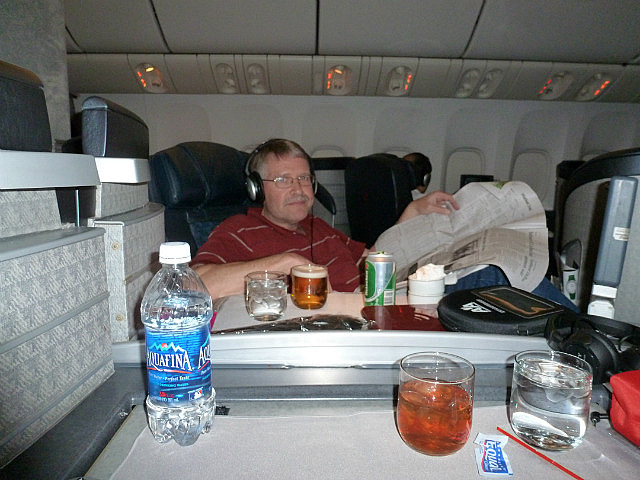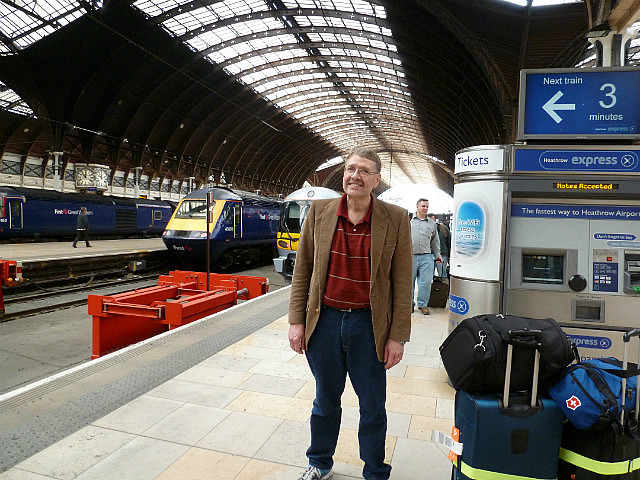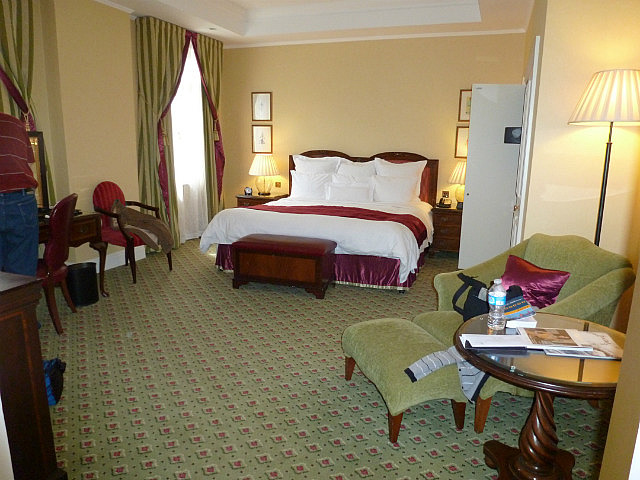Profile
Blog
Photos
Videos
Mark & Robyn's Travels
I have been looking at the pictures I uploaded for yesterday and today and I keep seeing this fat guy with glasses and a mustache in the pictures and realized that is ME. Look back at the pictures from 2012 and the nice svelte person I was back then. I have gained 25 lbs since that trip as I have struggled with consistent work-outs, but good grief, what happened? I have now become the Overweight Idiot Tourist.
We arrived at London Heathrow at 11 am this morning. After making it through customs and taking the Heathrow Express to Paddington Station, we caught a cab to our hotel. The London cab drivers are the most interesting people I have ever met on any trip. The one who took us to our hotel did not disappoint. As we are driving through an area leading up to Hyde Park he begins giving us his opinion of the immigrants that have moved into the area and cultural changes that have been made--too many changes he didn't like it. You will always get an opinion from a London cabbie and it is best just to smile and nod whether you agree or not. However, the older native Londoners have seen drastic changes in specific neighborhoods around the city as more immigrants have moved to greater London and have a difficult time with the changes. It really is not any different than what many white Americans feel. I am used to hearing it in Texas and at one time or another we have all had these types of feelings. I don't condemn the cabbie and have empathy for his attitudes, but the world is changing so we must find ways to accept and adapt. Enough of my brief social commentary. Why do I bring this up? Well it kind of ties in with our afternoon adventure.
After checking in to our hotel and getting somewhat refreshed we headed out to go to the British Museum. We did not visit this museum two years ago and I wanted to make sure we got there this time. The British Museum has very large antiquity collections from ancient Greece and Egypt along with other civilizations in Asia, Africa, and Europe. The one object they have that I wanted to see was the Rosetta Stone. What I didn't realize was the vast amount of antiquities that were there that are not from England. As an amateur historian I want to see these items and I want to understand how museums are maintaining these very old and important pieces of history. I often overlook where the item came from and where it now resides. More on this shortly.
When we got to the museum, I had two impressions: first, it is massively big; second, because of the size and time constraints, we would have to pick and choose what to see. As we entered and tried to figure out where we wanted to go first I was suddenly struck by the number of other nationalities that were around me. With the amount of languages I was hearing and very few being English (or French or German) I felt like there were 10 people in the museum who were speaking English--eight manning the information booths and Robyn and I. We found the Rosetta Stone and it is amazing. The stone itself is a decree written around 196 B.C. affirming the coronation of Ptolemy V. It is written in three languages- hieroglyphics at the top, demotic in the middle, and ancient Greek at the bottom. Thomas Young, an English physicist, found that the name Ptolemy was in the hieroglyphics, and a few years later in 1822 French scholar Jean-Francois Champollion made the connection that the hieroglyphs were not just pictures but a language which unlocked a new understanding of ancient Egypt. The stone was discovered by Napoleon's troops in 1799 when they were digging the foundations of a new fort near the town of el-Rashid (Rosetta). The stone was turned over to the British as part of the 1801 Treaty of Alexandria after Napoleon was defeated. The stone has been exhibited in the British Museum since 1802. This is one of the most important finds related to Egyptology, even more important than the discovery of King Tut's tomb.
The room where the stone is exhibited contains many statues, sarcophaguses, and pieces of former temples. In a room nearby are pieces of the Acropolis from Greece which were taken during excavations in the 1840's. Another room contains an Easter Island statue. All fascinating to see and well preserved. Here is my question. Where do these items belong? In the British Museum or in the countries of origin? The argument goes both ways: are they safer here or in possibly less stable political environments?
After the British Museum we went to see a performance of Verdi's "Requiem" at Royal Albert Hall. It was given by a combination of four choirs (500-600 voices) and the Royal Philharmonic Orchestra. It was a spectacular performance in an unbelievable listening venue. Robyn, of course, took many pictures inside the Hall (including a couple of attempts at selfies- see pictures) and turned on the video part of her camera to record parts of the performance. This was done from inside her purse (since no recordings were supposed to be made) and it actually turned out quite well. I have attached one recording. Note that there is no picture (except the inside of her purse)- just sound.
Anyway, tomorrow we leave for Amsterdam where there will be more culture as we are attending a concert tomorrow night. I have no idea what has gotten into us.
We arrived at London Heathrow at 11 am this morning. After making it through customs and taking the Heathrow Express to Paddington Station, we caught a cab to our hotel. The London cab drivers are the most interesting people I have ever met on any trip. The one who took us to our hotel did not disappoint. As we are driving through an area leading up to Hyde Park he begins giving us his opinion of the immigrants that have moved into the area and cultural changes that have been made--too many changes he didn't like it. You will always get an opinion from a London cabbie and it is best just to smile and nod whether you agree or not. However, the older native Londoners have seen drastic changes in specific neighborhoods around the city as more immigrants have moved to greater London and have a difficult time with the changes. It really is not any different than what many white Americans feel. I am used to hearing it in Texas and at one time or another we have all had these types of feelings. I don't condemn the cabbie and have empathy for his attitudes, but the world is changing so we must find ways to accept and adapt. Enough of my brief social commentary. Why do I bring this up? Well it kind of ties in with our afternoon adventure.
After checking in to our hotel and getting somewhat refreshed we headed out to go to the British Museum. We did not visit this museum two years ago and I wanted to make sure we got there this time. The British Museum has very large antiquity collections from ancient Greece and Egypt along with other civilizations in Asia, Africa, and Europe. The one object they have that I wanted to see was the Rosetta Stone. What I didn't realize was the vast amount of antiquities that were there that are not from England. As an amateur historian I want to see these items and I want to understand how museums are maintaining these very old and important pieces of history. I often overlook where the item came from and where it now resides. More on this shortly.
When we got to the museum, I had two impressions: first, it is massively big; second, because of the size and time constraints, we would have to pick and choose what to see. As we entered and tried to figure out where we wanted to go first I was suddenly struck by the number of other nationalities that were around me. With the amount of languages I was hearing and very few being English (or French or German) I felt like there were 10 people in the museum who were speaking English--eight manning the information booths and Robyn and I. We found the Rosetta Stone and it is amazing. The stone itself is a decree written around 196 B.C. affirming the coronation of Ptolemy V. It is written in three languages- hieroglyphics at the top, demotic in the middle, and ancient Greek at the bottom. Thomas Young, an English physicist, found that the name Ptolemy was in the hieroglyphics, and a few years later in 1822 French scholar Jean-Francois Champollion made the connection that the hieroglyphs were not just pictures but a language which unlocked a new understanding of ancient Egypt. The stone was discovered by Napoleon's troops in 1799 when they were digging the foundations of a new fort near the town of el-Rashid (Rosetta). The stone was turned over to the British as part of the 1801 Treaty of Alexandria after Napoleon was defeated. The stone has been exhibited in the British Museum since 1802. This is one of the most important finds related to Egyptology, even more important than the discovery of King Tut's tomb.
The room where the stone is exhibited contains many statues, sarcophaguses, and pieces of former temples. In a room nearby are pieces of the Acropolis from Greece which were taken during excavations in the 1840's. Another room contains an Easter Island statue. All fascinating to see and well preserved. Here is my question. Where do these items belong? In the British Museum or in the countries of origin? The argument goes both ways: are they safer here or in possibly less stable political environments?
After the British Museum we went to see a performance of Verdi's "Requiem" at Royal Albert Hall. It was given by a combination of four choirs (500-600 voices) and the Royal Philharmonic Orchestra. It was a spectacular performance in an unbelievable listening venue. Robyn, of course, took many pictures inside the Hall (including a couple of attempts at selfies- see pictures) and turned on the video part of her camera to record parts of the performance. This was done from inside her purse (since no recordings were supposed to be made) and it actually turned out quite well. I have attached one recording. Note that there is no picture (except the inside of her purse)- just sound.
Anyway, tomorrow we leave for Amsterdam where there will be more culture as we are attending a concert tomorrow night. I have no idea what has gotten into us.
- comments











Debby I will have to go back and see how your weight has fluctuated in two years. I feel your pain, after losing 17 pounds last summer, then Ronnie getting sick and then Sue, hospital food is not known for its low calorie content. Of course Liz kept bringing PBC's and oatmeal chocolate chip cookies to the hospital and we all know, you can't eat just one. Nice pictures though. Looks like you two lovebirds are having a fun time. Other than the guy relieving himself of the airline food on the flight over. Have fun, we are waiting for the pool guy. We know how to have a good time.
Jason Riehs OMG!! Looks like you guys are having so much fun! Im jealous. Enjoy every minute; the Texas heat will be in full force by the time you get back, so savor the weather!!
Melanie Sadly I'm just getting to reading the blog. So far off to a great start. I am intrigued by this Rosetta Stone. I never knew this existed but makes sense as to why Rosetta Stone, the language company, would name themselves that, pretty clever if you ask me. And tell mother she is to never take another "selfie" again, that first one is priceless and almost goes up there with the dolphins pics from the cruise.
mark_robyn There are more selfies to come.